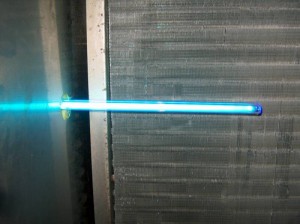Ultraviolet Lighting in HVAC units
Ultraviolet lighting in HVAC units has increased substantially over the years with the
sudden interested in maintaining a healthy indoor environment. This article will
introduce you to the basics of Ultraviolet Lighting
Definition of Ultraviolet Lighting
A rainbow is made when light shines through droplets of water and breaks into is various
colors. The light just beyond the violet end of the spectrum is not visible to the naked
eye and is called ultraviolet light, also commonly knows as UV Light
There are three types of UV light
The three types of UV light are A, B and C representing a different section of the UV light spectrum.
Type C known as UVC is the form used for germicidal activity, When UVC is used for germicidal purposes, it is known as UVGI.
UVGI “deactivates” or kills microorganisms, including viruses, bacteria, molds and other fungi by disrupting their DNA.
UVC is used for
- Surface disinfection
- HVAC Air disinfection
- Cooling Coil disinfection
- Water treatment
- Curing plastics and other materials
- Printing
- Chemical Processing
Application in HVAC Systems
UVGI lamps are categorized by the internal pressure of the gas in the lamp. Low pressure
lamps are the most common types of lamps found in HVAC system.
On hard surfaces like evaporator coils and drain pans the UVGI exposure is constant and the kill rate is up to 99.9%.
Bio aerosols is a more complex activity and affected by different factors such as system install, number of lamps and
lamp placement. Any installation of a UVC lamp in an HVAC system should include a method of visually inspecting it
periodically. Dirty lamps will result in reduced effectiveness. If the lamp becomes dirty, it should be cleaned with a
lint-free cloth and glass cleaner or alcohol. Never clean the lamp while it is turned on.
Hazards of Ultraviolet Lightings
Material decomposition is a concern in HVAC systems. UVGI can seriously degrade organic materials over time in a HVAC system,
including filters, sealants, gaskets and wiring insulation, resulting in air leaks, fire hazards and loss of system performance.
It is best to shield all organic material components within 5 feet of the UV lamp.
Skin and eyes have to be protected when exposed to UVA or UVB Ocular damage can occur 6-12 hours after initial exposure.
skin damage from excess exposure is similar to sunburn. Proper protection must be used when working with lamps.
Mercury Exposure is also a concern. UVC lamps contain a small amount of toxic Mercury, so if a bulb breaks ,
care should be taken to reduce exposure to the Mercury.
Best Practises
It is generally agreed that source removal (Duct Cleaning) of contaminants is the single best method for cleaning and
decontaminating the HVAC system.
If Ultra Violets lights are installed in the HVAC system without proper training, UVC lamps can be ineffective and can
create hazards or material decomposition that can negatively impact the efficiency of the system.
It is recommended that the installers be well educated on the materials from the manufacturer and in the ASHRAE Handbook – HVAC Systems and Equipment Chapter 17: Ultraviolet Lamp Systems
References
Nadca Nadca White paper on Ultraviolet lighting applications in HVAC Systems
Ashae Ashrae website – HVAC systems and equipment

